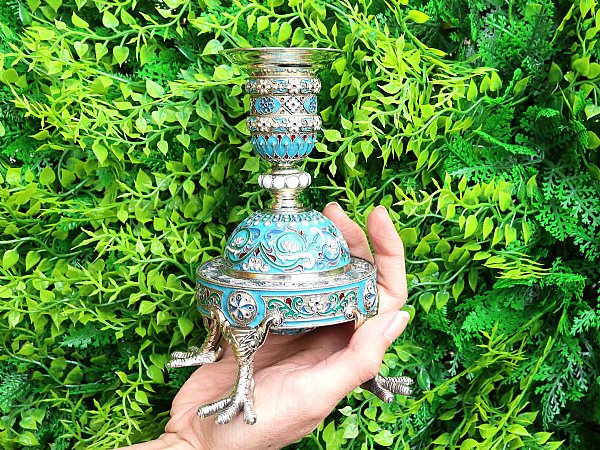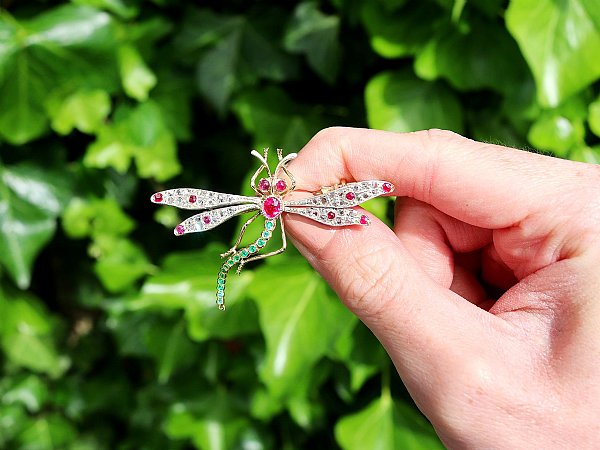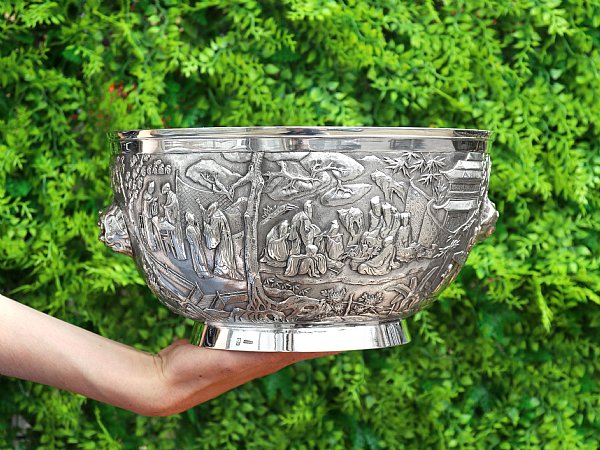Search Results for: '{{searchText}}'
Sorry...
We don't seem to have what you're looking for.
However we do have thousands of magnificent pieces of silver and jewellery available for you to view online. Browse our store using one of these categories.
Please wait for loading data... 
Russian silverware is unique as Russia is a country which sought standardisation of its silver purity and much earlier than most, with their laws regarding hallmarking being passed in 1700, which are the same standards which are abided by today.
Russian silver is incredibly beautiful, and often highly sought after, due to the impressive floral and pastoral ornamentation which was favoured by the Russian makers. Our collection of antique Russian silverware features items from the eighteenth, nineteenth and twentieth centuries, alongside vintage items.
All of these pieces are in presentation condition and are the finest examples of their type which we have found. These pieces make ideal antique gifts, and can be used practically or for display purposes.
Andrew Campbell, using his 40 years experience within the antique industry, handpicks all Russian silverware for sale.

Russia had rarely been considered part of Europe before the reign of Tsar Peter I, Peter the Great (r 1682 – 1725). His supremacy saw the start of the transformation towards Westernisation. It was Tsar Peter who founded St Petersburg in 1703, which went on to surpass Moscow as the empire’s largest city.
By the late 1700’s, German-born Catherine the Great (r 1762 – 96) who had overthrown her husband Peter III in a coup d’©tat to become Empress, continued Russia’s Westernisation by commissioning German furniture, Sevres porcelain, artwork and goods from Europe. Catherine patronised craftsmen and local silversmiths, encouraging them to move from the provinces to St Petersburg and Riga. Catherine extended the tsar’s Winter Palace by building what was known as the ‘Little Hermitage’ to house and display her fantastic art collection.
The Russian standard for silver is based on the zolotnik . This word is derived from the word ‘zoloto’ which actually means gold. The unit originated as the weight of a gold coin of the same name circulating around the late 11th century in Kievan Russia. A zolotnik originally represented a 1/96th of a pound , then later, 1/72nd of a pound. In the metric system, one zolotnik is equal to 4.266 grams/0.15 ounces and 96 zolotniks equal one Russian pound.
Russian marks converted to sterling values of silver purity degree:
84 zol. = 875/1000
88 zol. = 916.6/1000
91 zol. = 947.9/1000
In 1872 that Peter Carl Faberg© a young Russian jeweller, of French descent, volunteered to help and restore the antique treasures. Impressed with Faberg©â€™s craftsmanship Tsar Alexander III (r 1881 – 1894) appointed Faberg© Imperial Court Jeweller. Although every ornamental egg produced by Faberg© for the Royal Family was unique, Faberg©â€™s workshop employed over five hundred craftsmen and silversmiths, and it was through these hands each piece was created. Faberg© designed many silver items such as hollow ware, tea services, vases and decorative boxes for the Imperial Court, and specific items, such as candelabra presented to the Russian ballerina Anna Pavlova at the turn of the century.
The first, and most famous Silversmith’s Artel, (ICA) a semi-formal co-operative of silversmiths, was supported via the House of Faberg© in St Petersburg from 1909.
Artels consisted of only a small number of craftsmen who specialised in a specific area such as Russian silver, enamel, glass, creating limited designs and pieces (the opposite of mass production). Although each artel had its own hallmark, some artels could be recognised by the designs or colours used to embellish their pieces.
Little information is available about the thirty-four artels.
Although Faberg© is perhaps the most famous Russian craftsman, other recognised Russian silversmiths are Ovchinnikov, Sazikov, Nicholls and Plinke, Khlebnikov, Ruckert , Gratchev and the Artels.
Niello the process of inlaying a black mixture into engraved or etched metal; this usually consists of sulphur, copper, silver and lead. The powder or paste is applied to the item and then fired, allowing the melting properties to flow into the required lines, and hardens once cooled.
Cloisonn© decoration is named after ‘Cloisons’ – which translates to ‘compartments’ in French, referring to the compartments of colour that the decoration is defined by.
Although the name Cloisonn© is French, most antique and vintage pieces found in this style are created in Russia; where this adornment is especially popular.
Cloisonne enamel decoration is created by first soldering the wire work to the piece to form the shapes and compartments, reflecting the overall design. Powdered enamel is then made into a paste and applied to the metal within each small ‘cloison’, and the piece is fired in a kiln, where the high temperature melts the paste into an enamel.
Through this technique, different effects can be achieved depending on the type of enamel powder used. The maker can use less concentrated coloured powder, which will give the effect of a more translucent colour, resembling a stained-glass effect.
There is evidence of variations of the cloisonn© technique as far back as Ancient Egypt, where Pharaoh’s chest plates were decorated with large, turquoise-coloured enamelling. During the Byzantine Empire, the small and delicate wirework was developed and primarily used to decorate items of religious and ceremonial significance. Often, during these ancient eras, most examples of cloisonn© work were smaller pieces, such as jewellery.
It was not only powdered enamel which was used to create the cloisonn© decoration effect, but many pieces in this style were made with gemstones and paste stones; paste stones are comprised of glass with a coloured backing. The use of gemstones and paste stones in this way was primarily for display, and garnets were commonly used by royalty as they were believed to be a protective stone, therefore were often incorporated into pieces of armour or swords. Furthermore, the garnet was a symbol of the Blood of Christ to those who followed Christianity, so the gemstone was used frequently in cloisonn© items which were used within a church.
Russian hallmarking system changed in 1899 to the marks we see today.
Prior to 1899 the hallmark for St Petersburg was the city’s coat of arms of crossed anchors and sceptre followed by the metal standard in zolotniks. The image shows the 14 ct gold standard.

For Moscow, the hallmark was the city’s coat of arms also, this time depicting St George and his dragon. The metal standard in zolotniks would also be stamped alongside it.
Once the new system was adopted in 1899, a uniform mark was used to hallmark Russian silver. The kokoshnik (the traditional woman’s headdress) is now the symbol for silver, followed again by the metal standard in zolotniks. Prior to 1908 the symbol faced to the left, however any silver produced after this year will depict the face to the right.



After the right facing kokoshnik was introduced in 1908, the two cities were distinguished by the Greek letter alpha for St Petersburg and delta for Moscow.
The beautiful enamelling that is the famous tell tale of Russian silver is what makes it so desirable. Be sure that the pieces you are purchasing are the ‘real thing’ by researching and/or understanding the hallmarks.




